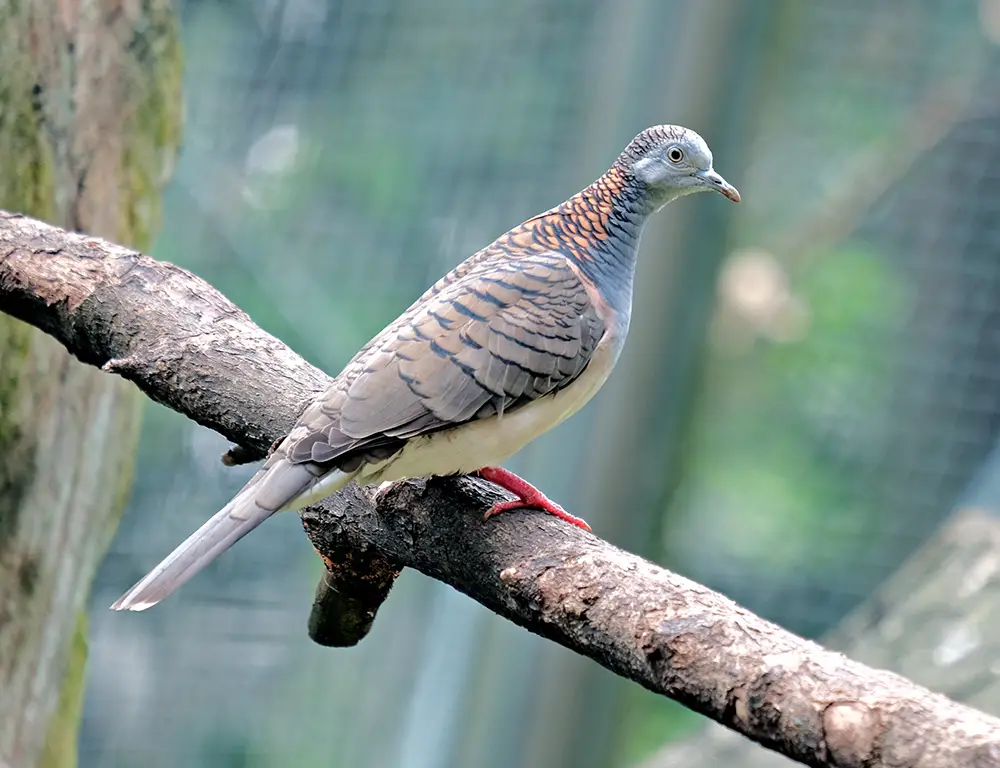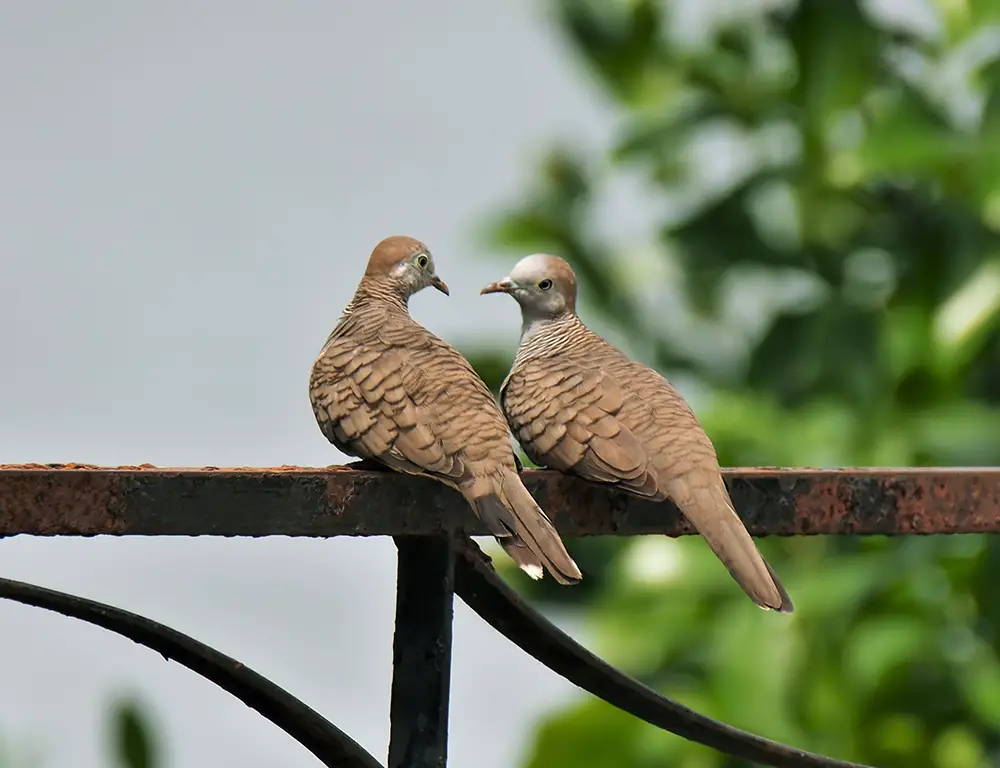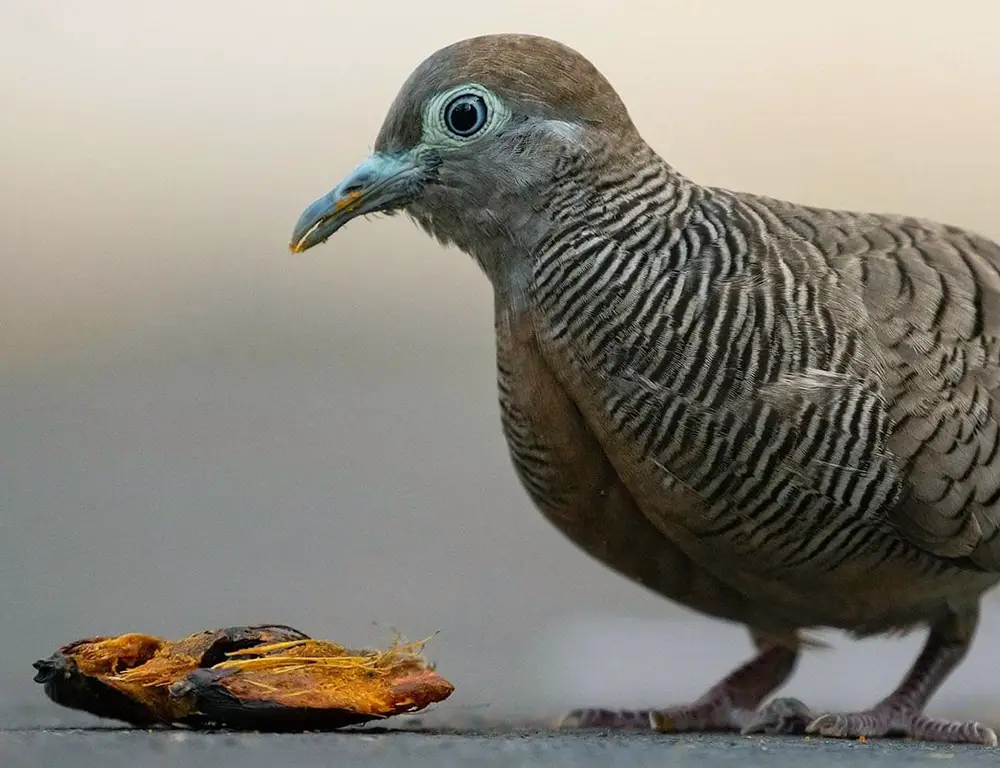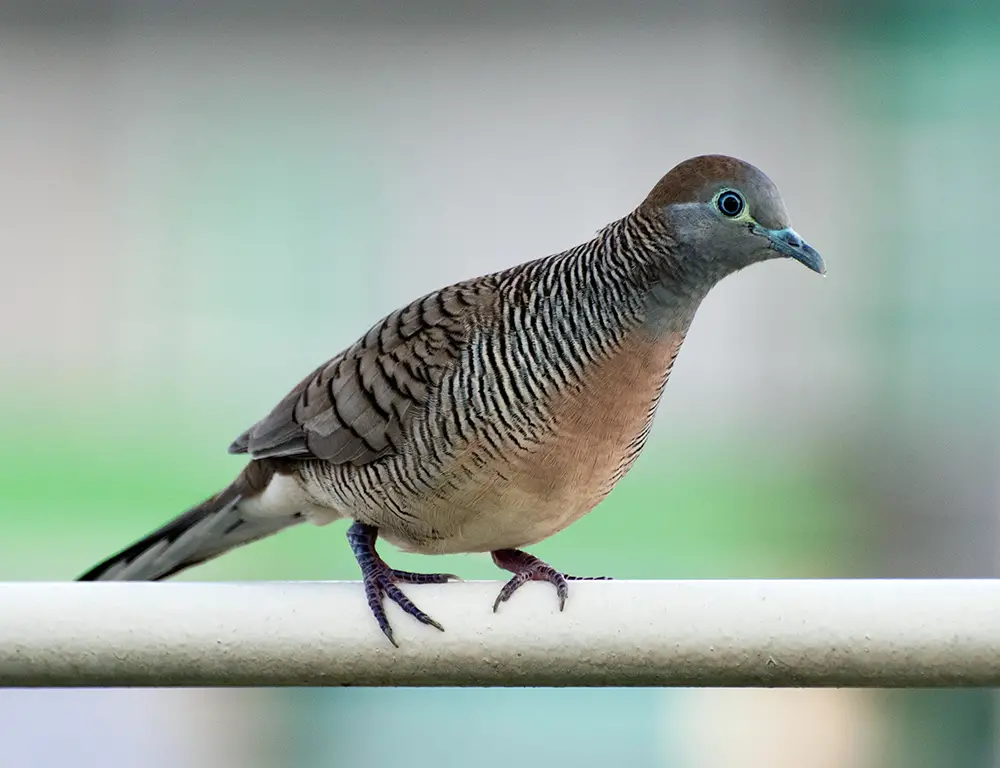Step into the serene world of the Zebra Dove (Geopelia striata), a delicate yet resilient avian species that graces the landscapes of tropical and subtropical regions with its gentle presence.
With its striking plumage and melodious cooing, the Zebra Dove embodies the essence of tranquility and harmony in nature’s tapestry.
The Zebra Dove, or the Barred Ground Dove or Peaceful Dove, is renowned for its subtle beauty and understated elegance.
Adorned with intricate patterns of black and white stripes on its feathers, reminiscent of a zebra’s markings, this diminutive bird captivates observers with its unassuming charm.
Join us to discover the enchanting world of the Zebra Dove as we unravel its unique characteristics, behaviors, and ecological significance.
From its soothing calls that echo through tropical gardens to its role in seed dispersal and ecosystem dynamics, the Zebra Dove invites us to embrace the tranquility of nature’s symphony.

Physical Characteristics of the Zebra Dove
The Zebra Dove is a charming and widely distributed bird species in Southeast Asia and parts of Australia.
Known for its subtle beauty and gentle demeanor, the Zebra Dove possesses several vital physical characteristics that distinguish it from other dove species:
Size and Shape
Zebra Doves are small to medium-sized birds, measuring approximately 20 to 23 centimeters (8 to 9 inches) in length, including their tail. They have a compact, rounded body with a short neck and small head, giving them a distinctively plump appearance.
Plumage
The plumage of the Zebra Dove is characterized by its subtle yet striking pattern of black and white stripes, reminiscent of a zebra’s markings. The upperparts are primarily brown with fine black barring, while the underparts are pale buff or greyish-white.
The wings and tail display prominent black and white stripes, adding to the bird’s distinctive appearance.
Head and Facial Features
Zebra Doves have a small, rounded head with a delicate bill and large, dark eyes. Their facial features are relatively plain, with a subtle pattern of fine black lines extending from the eyes to the neck. The cheeks and throat are typically pale grey or buff.
Legs and Feet
The legs and feet of Zebra Doves are relatively short and slender, adapted for perching and walking on the ground. They are typically pale pink or grey, blending seamlessly with the bird’s overall plumage.
Voice
Zebra Doves is known for its musical cooing calls, which they use for communication and courtship. The typical call is a soft, repetitive “coo-coo-coo,” often uttered in a rhythmic pattern. Males may also produce a series of coos during courtship displays to attract mates.
Flight Pattern
Zebra Doves have a buoyant and agile flight, characterized by rapid wingbeats interspersed with glides. They often fly low to the ground, with a distinctive whirring sound produced by their wingbeats.
Behavior

Zebra Doves are typically ground-dwelling birds, foraging for food on the forest floor or in open grassy areas. They are often observed walking or running with quick, jerky movements, using their slender bills to probe for seeds, grains, insects, and small invertebrates.
Habitat Preference
Zebra Doves are adaptable birds in various habitats, including open woodlands, scrublands, agricultural areas, parks, and gardens. They are ubiquitous in urban and suburban environments, exploiting food sources such as seeds, grains, and discarded scraps.
Social Structure
Zebra Doves are generally solitary or found in pairs during the breeding season. However, they may form small flocks outside of the breeding season, especially around food sources such as feeding stations or grain fields.
Reproduction
Zebra Doves typically breed throughout the year, with peak breeding activity occurring during the wet season in tropical regions.
They construct simple nests made of twigs, grasses, and leaves in shrubs or trees, where the female lays a clutch of two eggs. Both parents share incubation and chick-rearing duties until the young fledge from the nest.
Taxonomy, Distribution, and Breeding Habits of the Zebra Dove
The Zebra Dove is a charming and adaptable bird species in Southeast Asia and parts of Australia. Let’s explore its taxonomy, distribution, and breeding habits to gain insights into this delightful avian species.
Taxonomy
| Taxonomy Level | Classification |
| Kingdom | Animalia |
| Phylum | Chordata |
| Class | Aves |
| Order | Columbiformes |
| Family | Columbidae |
| Genus | Geopelia |
| Species | Geopelia striata |
Range Map
The range map illustrates the distribution of the Zebra Dove across its habitat range, including Southeast Asia and parts of Australia. It highlights the areas where these doves are commonly found, such as open woodlands, scrublands, agricultural areas, parks, and gardens.
Food Habits

Zebra Doves primarily feed on various seeds, grains, and small invertebrates found on the ground. They use their slender bills to probe for food in the leaf litter and open grassy areas, often foraging in pairs or small groups.
Nesting
| Nesting Habit | Description |
| Nest Location | Shrubs or trees |
| Nest Composition | Simple nest made of twigs, grasses, and leaves |
| Clutch Size | Typically contains 2 eggs |
| Incubation Period | Around 14-18 days |
| Parental Care | Both males and females share incubation and care |
Breeding
Zebra Doves breed throughout the year, with peak breeding activity occurring during the wet season in tropical regions. They construct simple nests in shrubs or trees, where the female lays a clutch of two eggs.
Both parents share incubation and chick-rearing duties until the young fledge from the nest.
Diseases and Treatments
Zebra Doves may be susceptible to various avian diseases, including respiratory infections, parasitic infestations, and injuries. Treatment typically involves veterinary care, including antibiotics, antiparasitic medications, and supportive therapy to aid recovery.
Regular observation and monitoring of health status can help prevent and manage potential diseases in captive and wild populations of Zebra Doves.
Is the Zebra Dove Endangered?
The Zebra Dove is not currently considered endangered. It is listed as a species of “Least Concern” by the International Union for Conservation of Nature (IUCN).
However, like many bird species, the Zebra Dove faces habitat loss, fragmentation, and urbanization threats. Conservation efforts focused on preserving its habitat and raising awareness about its importance can help ensure the continued well-being of this charming bird species.
8 Interesting Facts About the Zebra Dove

Discover fascinating insights into the charming world of the Zebra Dove, a delightful avian species found across Southeast Asia and parts of Australia.
1. Distinctive Plumage
The Zebra Dove is named for its striking plumage, which features black and white stripes on its neck and breast, resembling the markings of a zebra.
2. Mellow Coos
These doves are known for their gentle and soothing cooing calls, which they use for communication and courtship. The soft “coo-coo-coo” sound adds to the peaceful ambiance of their habitat.
3. Urban Adaptability
Zebra Doves are highly adaptable to urban environments and are commonly found in parks, gardens, and residential areas, where they forage for food and build their nests.
4. Monogamous Pairs
During the breeding season, Zebra Doves form monogamous pairs and share nesting and chick-rearing duties. This cooperative behavior strengthens their bond as mates.
5. Year-Round Breeding
Unlike many bird species, Zebra Doves breed throughout the year, with peak breeding activity occurring during the wet season in tropical regions.
6. Ground-Nesting Habit
These doves construct simple nests of twigs, grasses, and leaves on the ground or in low shrubs. This nesting behavior makes them vulnerable to predation but also provides easy access to food and shelter.
7. Dietary Diversity
Zebra Doves have a varied diet that includes seeds, grains, insects, and small invertebrates. They forage on the ground, using their slender bills to probe for food among leaf litter and grass.
8. Symbol of Peace
Doves, including the Zebra Dove, symbolize peace, love, and harmony in many cultures. Their gentle presence and melodious calls evoke tranquility and serenity in natural and urban settings alike.
FAQs
What is a Zebra Dove?
The Zebra Dove is a species of bird belonging to the dove family Columbidae. It is known for its distinctive black and white striped plumage on its neck and breast, resembling the markings of a zebra.
Where do Zebra Doves live?
Zebra Doves are native to Southeast Asia and parts of Australia. They inhabit various habitats, including open woodlands, scrublands, agricultural areas, parks, and gardens.
They are highly adaptable to urban environments and are commonly found in residential areas.
What do Zebra Doves eat?
Zebra Doves have a diverse diet, including seeds, grains, insects, and small invertebrates. They forage on the ground, using their slender bills to probe for food among leaf litter and grass in search of seeds, grains, insects, and small invertebrates.
Are Zebra Doves monogamous?
Yes, Zebra Doves are monogamous birds. During breeding, they form monogamous pairs and share nesting and chick-rearing duties. This cooperative behavior strengthens their bond as mates.
Are Zebra Doves endangered?
Zebra Doves are not considered endangered. They are listed as a species of “Least Concern” by the International Union for Conservation of Nature (IUCN). However, they may face threats such as habitat loss, urbanization, and predation in some areas.
Conclusion
To wrap it all up, the Zebra Dove is a testament to the beauty and tranquility of the natural world. With its graceful demeanor and melodious cooing, this avian species enriches the landscapes it inhabits, bringing a sense of serenity to tropical and subtropical regions.
As a symbol of peace and harmony, the Zebra Dove reminds us to preserve the delicate balance of ecosystems and embrace the beauty of biodiversity.
By protecting the habitats where the Zebra Dove thrives, we safeguard the future of this enchanting bird and ensure the conservation of the diverse flora and fauna that share its environment.
Let us continue to cherish and appreciate the presence of the Zebra Dove and work together to promote conservation efforts that uphold the tranquility and splendor of our natural world for generations to come.